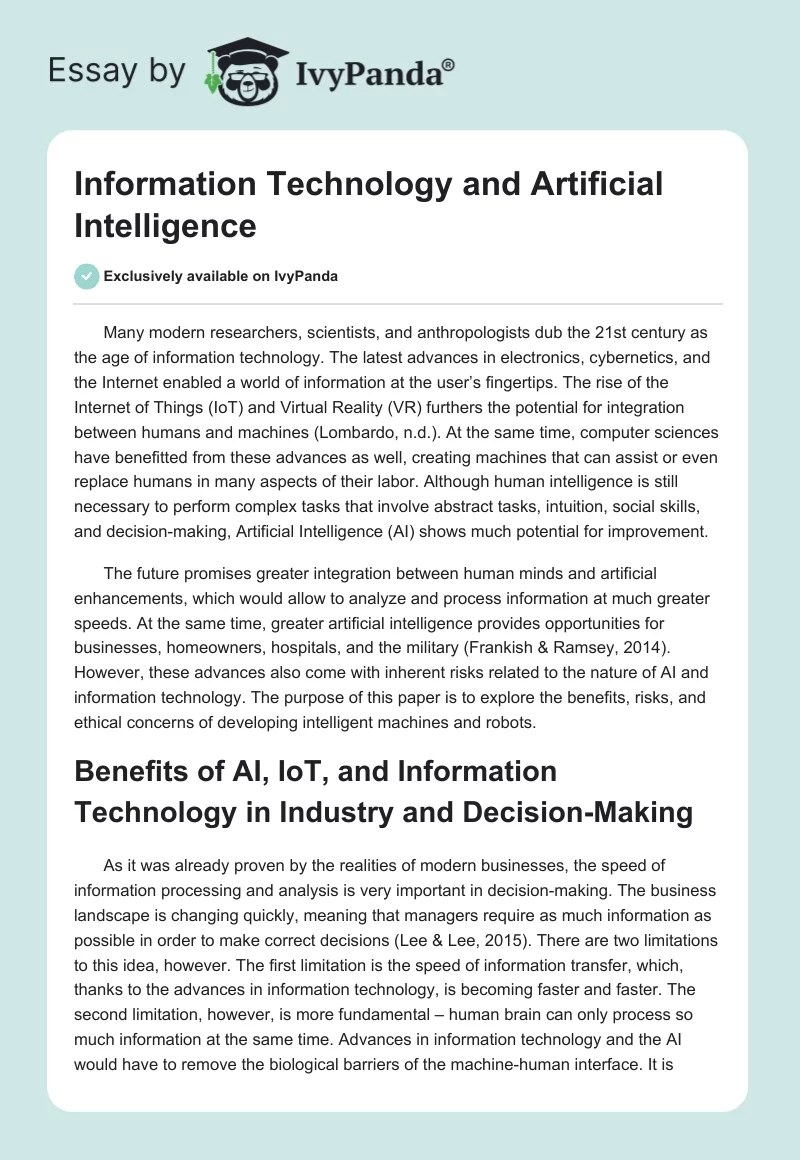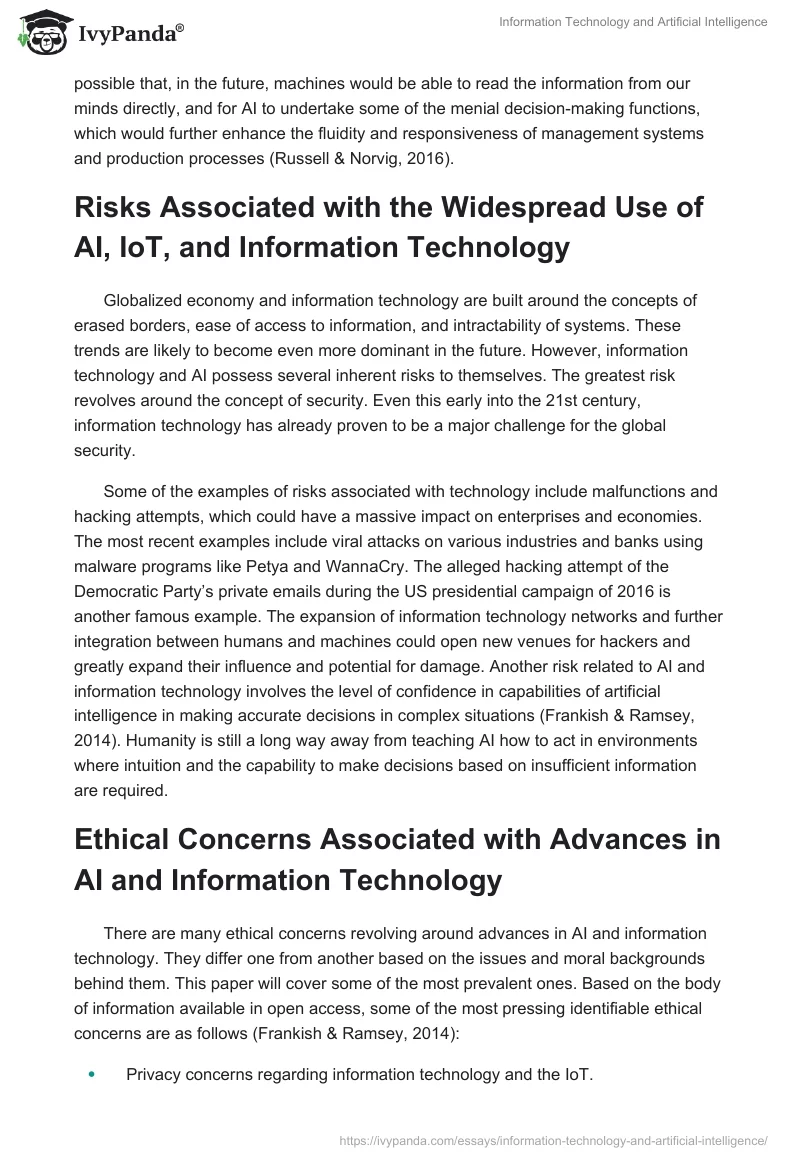Many modern researchers, scientists, and anthropologists dub the 21st century as the age of information technology. The latest advances in electronics, cybernetics, and the Internet enabled a world of information at the user’s fingertips. The rise of the Internet of Things (IoT) and Virtual Reality (VR) furthers the potential for integration between humans and machines (Lombardo, n.d.). At the same time, computer sciences have benefitted from these advances as well, creating machines that can assist or even replace humans in many aspects of their labor. Although human intelligence is still necessary to perform complex tasks that involve abstract tasks, intuition, social skills, and decision-making, Artificial Intelligence (AI) shows much potential for improvement.
The future promises greater integration between human minds and artificial enhancements, which would allow to analyze and process information at much greater speeds. At the same time, greater artificial intelligence provides opportunities for businesses, homeowners, hospitals, and the military (Frankish & Ramsey, 2014). However, these advances also come with inherent risks related to the nature of AI and information technology. The purpose of this paper is to explore the benefits, risks, and ethical concerns of developing intelligent machines and robots.
Benefits of AI, IoT, and Information Technology in Industry and Decision-Making
As it was already proven by the realities of modern businesses, the speed of information processing and analysis is very important in decision-making. The business landscape is changing quickly, meaning that managers require as much information as possible in order to make correct decisions (Lee & Lee, 2015). There are two limitations to this idea, however. The first limitation is the speed of information transfer, which, thanks to the advances in information technology, is becoming faster and faster. The second limitation, however, is more fundamental – human brain can only process so much information at the same time. Advances in information technology and the AI would have to remove the biological barriers of the machine-human interface. It is possible that, in the future, machines would be able to read the information from our minds directly, and for AI to undertake some of the menial decision-making functions, which would further enhance the fluidity and responsiveness of management systems and production processes (Russell & Norvig, 2016).
Risks Associated with the Widespread Use of AI, IoT, and Information Technology
Globalized economy and information technology are built around the concepts of erased borders, ease of access to information, and intractability of systems. These trends are likely to become even more dominant in the future. However, information technology and AI possess several inherent risks to themselves. The greatest risk revolves around the concept of security. Even this early into the 21st century, information technology has already proven to be a major challenge for the global security.
Some of the examples of risks associated with technology include malfunctions and hacking attempts, which could have a massive impact on enterprises and economies. The most recent examples include viral attacks on various industries and banks using malware programs like Petya and WannaCry. The alleged hacking attempt of the Democratic Party’s private emails during the US presidential campaign of 2016 is another famous example. The expansion of information technology networks and further integration between humans and machines could open new venues for hackers and greatly expand their influence and potential for damage. Another risk related to AI and information technology involves the level of confidence in capabilities of artificial intelligence in making accurate decisions in complex situations (Frankish & Ramsey, 2014). Humanity is still a long way away from teaching AI how to act in environments where intuition and the capability to make decisions based on insufficient information are required.
Ethical Concerns Associated with Advances in AI and Information Technology
There are many ethical concerns revolving around advances in AI and information technology. They differ one from another based on the issues and moral backgrounds behind them. This paper will cover some of the most prevalent ones. Based on the body of information available in open access, some of the most pressing identifiable ethical concerns are as follows (Frankish & Ramsey, 2014):
- Privacy concerns regarding information technology and the IoT.
- Ethical concerns regarding machines replacing humans at work, generating potential job crises and poverty.
- Ethical concerns regarding the exploitation of sentient machines.
- Concerns regarding sentient machines being capable of understanding and utilizing human ethics in their work.
Privacy concerns are some of the greatest obstacles for IoT and the idea of interconnectedness of items and appliances. There are risks of personal customer data being used for unsavory and unethical purposes (Lee & Lee, 2015). Some of the latest examples involve unethical and unauthorized data collection by social media, search engines, and governmental agencies with the purpose of using that information for commercial, criminal, and political reasons (Lombardo, n.d.).
The idea of mechanization and automation causing civil unrest is not new. During the industrial revolution of the 19th century, the introduction of engines and production plants resulted in thousands of workers and craftsmen ending up without jobs (this sentence refers to the events that led to the rise of Luddites – a radical group of textile workers that destroyed machinery that replaced their roles in the industry). Advancements in IT and AI have the potential of further decreasing the number of jobs available to humans, with disastrous social results (Frankish & Ramsey, 2014). The ethical dilemma would be in choosing between social stability and progress.
The third ethical issue revolves around exploitation of sentient machines. Sentience is defined by three criteria: Intelligence, self-awareness, and consciousness (although certain criteria differ from one research to another, it has been a general conception that capacity for emotion is not a core criteria for sentience). As AI is taken into the direction of neural networks, it is possible for AI to achieve all three criteria necessary for sentience (Russell & Norvig, 2016). Such an occasion would invariably raise ethical questions of machines having rights and the humanity effectively exploiting what would be called a new sentient species.
The last issue revolves around the limitations of machines to understand and correctly implement human ethics in decision-making processes. As it is impossible to predict and program answers for all morally ambiguous situations that advanced AI would encounter in the course of its duties, there is a necessity for an ethical framework for them (Frankish & Ramsey, 2014). However, making an ethical decision requires not only the capability for data analysis interpretation but also a degree of empathy, which is unlikely for a machine to possess. This begets the question about how much authority and responsibility could be delegated to an AI.
Conclusions
Advancements in IT and AI have the potential of greatly improving the lives of every human being on the planet by offering greater and faster access to information, enhanced processing power, and delegation of tasks to intelligent machines and computers. However, these advances invariantly raise questions regarding personal safety and data security. In addition, there are numerous ethical dilemmas revolving around making AI too intelligent and human-like. Finding answers to these questions promises to be as much of a challenge as advancing IT and AI beyond their current limitations.
References
Frankish, K., & Ramsey, W. M. (Eds.). (2014). The Cambridge handbook of artificial intelligence. Cambridge, UK: Cambridge University Press.
Lee, I., & Lee, K. (2015). The Internet of Things (IoT): Applications, investments, and challenges for enterprises. Business Horizons, 58(4), 431-440.
Lombardo, T. (n.d.). Information technology and artificial intelligence. Web.
Russell, S. J., & Norvig, P. (2016). Artificial intelligence: A modern approach. Kuala Lumpur, Malaysia: Pearson.


